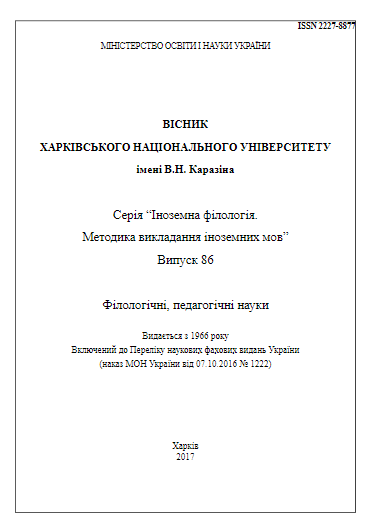The cognitive and functional approach to verbalization of movement in communicative space
Abstract
The paper addresses the problem of conceptualization of communicative space in English. Space is a fundamental notion of human thinking that represents a diversified nature of the world’s existence in its inhomogeneity; it is an environment of communicative activity and a necessary element of perceiving the world. Producing statements, communicants create communicative space. It consists of personal spaces of discursive personalities, which are the addresser’s and addressee’s ones that have a center and periphery with moveable boundaries. In a natural language, a mental representation of space is transformed into text. Studying the ways, in which motion in space is verbalized, remains one of the topical issues of the present-day linguistic research. Yet, motion in the personal or communicative space is still in need of an in-depth analysis. The research focuses on the image schematic structure of motion, which is actualized by verbal constructions of motion in space. Considering fragments that include expressions describing motion in the communicative space, we have revealed that the verbal constructions of motion in space actualize the source / path / goal schema with its binary oppositions (forward and back) and constituents, the part / whole schema by describing the whole-body or the part-body movement of the communicant, and the center / periphery schema that conceptualizes motion in space depending upon how far the communicant moves.
Downloads
References
Булыгина Т.В. Перемещение в пространстве как метафора эмоций / Т.В. Булыгина, А.Д. Шмелев // Логический анализ языка : Языки пространств : сб. науч. ст. ; [отв. ред. Н.Д. Арутюнова, И.Б. Левонтина]. – М. : Языки русской культуры, 2000. – С. 278–288.
Кубрякова Е.С. Язык и знание : На пути получения знаний о языке. Части речи с когнитивной точки зрения. Роль языка в познании мира / Е.С. Кубрякова. – М. : Языки славянской культуры, 2004. – 560 с.
Лебедева Л.Б. Семантика «ограничивающих» слов / Л.Б. Лебедева // Логический анализ языка : Языки пространств : сб. науч. ст. ; [отв. ред. Н.Д. Арутюнова, И.Б. Левонтина]. – М. : Языки русской культуры, 2000. – С. 93–105.
Мечковская Н.Б. Семиотика. Язык. Природа. Культура / Н.Б. Мечковская. – М. : Издательский центр «Академия», 2004. – 432 с.
Тошович Б. Глаголы каузации положения в пространстве / Бранко Тошович // Логический анализ языка : Языки пространств : сб. науч. ст. ; [отв. ред. Н.Д. Арутюнова, И.Б. Левонтина]. – М. : Языки русской культуры, 2000. – С. 163–175.
Fillmore Ch.J. Frame semantics and the nature of language [Electronic resource] / Ch.J. Fillmore. – 1976. – Available at : http://www.icsi.berkeley.edu/pubs/ai/framesemantics76.pdf.
Hall E.A. Proxemics / E.A. Hall // Current Anthropology. – 1968. – № 9. – P. 83–108.
Janzen T. Shared spaces, shared mind : connecting past and present viewpoints in American sign language narratives / Janzen T. // Book of abstracts. International cognitive linguistics conference : linguistic diversity and cognitive linguistics, 10-14 July 2017, Tartu, Estonia. – P. 144.
Johnson M. The body in the mind : the bodily basis of meaning, imagination, and reason / M. Johnson. – Chicago : The University of Chicago press, 1987. – 287 p.
Knapp M.L. Nonverbal communication in human interaction / M.L. Knapp, J.A. Hall. – Wadsworth : Thomson Learning, USA, 2002. – 482 p.
Hilferty J. Maximality and idealized cognitive models : the complementation of Spanish tener [Electronic resource]. / J. Hilferty. – 2001. – Available at : https://www.um.es/lincoing/jv/2001%20ICMs%20&%20tener%20Lang%20Sciences.pdf.
Lakoff G. Women, fire, and dangerous things. What categories reveal about the mind / Lakoff G. – Chicago ; London : The University of Chicago Press, 1987. – 387 p.
Langacker R.W. Foundations of cognitive grammar / Langacker R.W. // Theoretical prerequisites. – Stanford : Stanford University Press, 1987. – 353 p.
Manerko L. Towards understanding of conceptualization in cognitive terminology / Manerko L. // Lege artis. Language yesterday, today, tomorrow. The Journal of University of SS Cyril and Methodius in Trnava, 1(2), 2016. – P. 129–170. DOI : 10.1515/lart-2016-0012 ISSN 2453-8035.
Talmy L. Lexicalization patterns: semantic structure in lexical forms / Talmy L. // Language typology and syntactic description, 3, 1985. – P. 57–149.
Wendland E.R. Framing the frames : a theoretical framework for the cognitive notion of «frames of reference» / E.R. Wendland // Journal of translation, 6, 2010. – P. 27–50.




